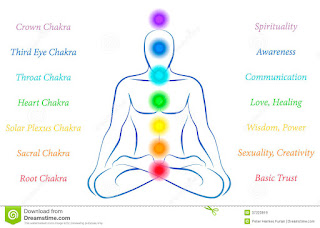The theme of our last class was the Muladhara or root chakra. The poses grounded us to help stabilize our nervous system. I used the elements of this chakra to guide you to a deeper, fuller experience in the restorative pose. It dawned on me later that afternoon, that perhaps the chakra system is unknown to you. In this blog, I will share what the chakras are and a few elements that I used to guide you through the practice this week. Enjoy!
What is a Chakra? a whirling vortex of energy like the sun’s rays sending out energy in all directions and receiving energy. They are in the subtle body, along the spine. The energy at these points can be in 3 states of nature, tammasic (inactive leading to inertia), rajasic (hyperactive) and sattvic (balanced). If you were to visualize the three states of a plant, tammasic would be the seed, rajasic would be the growing plant from the seed and sattvic is the fruit or flower of the plant. There are 7 chakras which are closest to the systems of the nerves and the endocrine. There are also similarities with the Christian sacraments and the Jewish Tree of Life of the Kabbalah.
*Note Mantra sounds are called Bija or seed mantras as you chant them they stimulate that chakra.
1st Chakra – Muladhara (Root) – LAM mantra sound
- red
- earth
- your tribe, connection to others, sense of belonging, identity, trust
- sense of smell
- fear resides here and desire for survival
- organs of elimination (digestive, skin, kidneys), musculoskeletal system
- belief systems and honor come from this chakra
- emotional imbalances (depression, insomnia)
2nd Chakra – Swadhisthana (Sacral) – VAM mantra sound
- orange
- water
- relationships with others, creativity, procreation, awareness of self
- sense of taste
- duality of attraction/repulsion resides here, passion
- reproductive organs, liquids in the body
- sense of morality, emotional ebbs and flows
3rd Chakra – Manipura (Solar Plexus) – RAM mantra sound
- yellow
- fire
- source of power, intellect and vitality
- sense of sight
- idea of thinking, ego resides here
- digestive system, endocrines
- emotion of anger, rightness, judgemental or powerless (addictions)
4th Chakra – Anahata (Heart) – Yam mantra sound
- green
- air
- feelings, love, compassion, joy, intuition
- sense of touch
- the immune system, glands, heart, lungs, breasts, arms (extension of heart)
- duality of sun “ha” and moon “tha or ta”. When the come together, we become ONE, living in harmony with all
- the crossing over point from the earth element to the subtle element (diaphragm)
5th Chakra – Vishuddh (Throat) – HUM mantra sound
- blue
- ether, the final earth element
- truth, communication (speaking and listening), faith
- sense of hearing
- thyroid gland, mouth, throat, gums, vocal cords
- place where time begins and ends, time doesn’t exist here
6th Chakra – Ajna (Third Eye) – OM mantra sound
- purple
- above duality
- place of intuition, beyond wisd
- om, clairvoyance
- eyes as organ of sense
- Pituitary gland, brain, neurological system
- discrimination between thoughts motivated by fear and those by strength
- here you have a combination between what we know and what we believe to be true – discernment
7th Chakra – Sahasara (Crown) – OM mantra sound
- clear color
- our spiritual connection
- where our karma is stored
- energy from the universe pours into this chakra and nourishes the mind, body and spirit and connects with the lower 6 chakras.
- influences the major body systems: central nervous system, muscular and the skin.
- energy of devotion, connection to mystic power
- fear of loss of identity, connection with life and others
The Poses
*This week, all poses were done at the wall.
Childs Pose
Modify as needed with a chair or in a straddle position.
Legs up the Wall
Props: 1-2 blankets, strap, eye pillow, blanket for warmth, neck roll, a bolster for behind legs
Benefits: increases circulation and helps venous and lymphatic flow from the lower body; relieves swelling and fatigue in the legs; helps relieve muscular skeletal stress in pelvis; quiets the mind and can help promote ease in meditation and sleep.
Begin with using a double-folded blanket to be placed right above sacrum (see photo), setting it approx. distance 6-8″ from wall (adjust in pose). Sit down on the blanket with one hip pressed right up against the wall. As you lower down, swing your legs up the wall. Once in the pose, you can adjust distance to wall, angle of legs to all, blanket and placement of legs all for comfort. Hips and tailbone will be in space between wall and blanket. Arms rest by your side, palms face up or variation with Goddess arms (photo above).
Grounded Savasana
Props: 2-3 blankets
Benefits: relaxes the nervous system, gentle stretch for chest, arms, shoulders, ease in breathing, grounding
Lay down on floor with feet touching the wall, arms comfortably by your side. Support head, neck, back and knees with additional blankets or pillows. Cover for extra grounding and warmth.


Leave A Comment